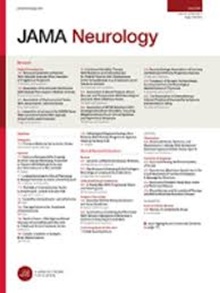Novel Meningoencephalomyelitis Associated With Vimentin IgG Autoantibodies.
IF 21.3
1区 医学
Q1 CLINICAL NEUROLOGY
引用次数: 0
Abstract
Importance Autoantibodies targeting astrocytes, such as those against glial fibrillary acidic protein (GFAP) or aquaporin protein 4, are crucial diagnostic markers for autoimmune astrocytopathy among central nervous system (CNS) autoimmune disorders. However, diagnosis remains challenging for patients lacking specific autoantibodies. Objective To characterize a syndrome of unknown meningoencephalomyelitis associated with an astrocytic autoantibody. Design, Setting, and Participants This retrospective case series study included samples collected from April 2021 to May 2024 at a tertiary referral hospital among patients with uncharacterized CNS autoimmune disorders and similar clinical and radiological features. Single-cell RNA sequencing (scRNA-seq) was performed on cerebrospinal fluid (CSF) cells of 2 index patients to identify the putative target antigen of the clonally expanded B cells. A comprehensive screening for additional patients was conducted using blinded cell-based and tissue-based assay. Candidate patients were followed up for a median (range) duration of 23 (5-31) months. Exposures scRNA-seq, autoantibody characterization, and testing. Main Outcomes and Measures Detection of the autoantibody and characterization of the associated autoimmune meningoencephalomyelitis. Results Fourteen candidate patients (10 [71%] female; median [IQR] age, 33 [23-41] years) were identified. Initially, CSF from 2 female patients with unknown encephalomyelitis showed astrocytic reactivity on rat tissue but was negative for GFAP IgG. A total of 17 of 37 clonally expanded B cell clonotypes (46%) in their CSF expressed IgG autoantibodies targeting the astrocytic intermediate filament protein vimentin. Subsequent screening identified 12 additional patients. These 14 patients shared a unique clinical profile characterized by relapsing courses and symptoms prominently involving the cerebellum, brainstem, and corticospinal tract (CST). All patients also exhibited elevated CSF protein and cells, intrathecal immunoglobulin synthesis, and magnetic resonance imaging (MRI) showing bilateral lesions on CST. Notably, 8 of 12 patients (67%) who received first-line immunotherapy at their first episode responded well. At the last follow-up, 11 patients (79%) experienced significant disability (modified Rankin Scale ≥3). Conclusions and Relevance In this case series, autoantibodies targeting the astrocytic intermediate filament protein vimentin were identified in patients with previously undifferentiated meningoencephalomyelitis and common radiographic features.与Vimentin IgG自身抗体相关的新型脑膜脊髓炎。
针对星形胶质细胞的自身抗体,如针对胶质纤维酸性蛋白(GFAP)或水通道蛋白4的抗体,是中枢神经系统(CNS)自身免疫性疾病中自身免疫性星形胶质细胞病的重要诊断标志物。然而,对于缺乏特异性自身抗体的患者,诊断仍然具有挑战性。目的探讨不明原因脑膜脑脊髓炎伴星形细胞自身抗体的特点。设计、环境和参与者本回顾性病例系列研究包括2021年4月至2024年5月在一家三级转诊医院收集的具有非特征性中枢神经系统自身免疫性疾病和类似临床和放射学特征的患者的样本。对2例患者脑脊液细胞进行单细胞RNA测序(scRNA-seq),鉴定克隆扩增B细胞的推定靶抗原。使用基于细胞和组织的盲法对其他患者进行全面筛查。候选患者的中位(范围)随访时间为23(5-31)个月。暴露scrna -seq,自身抗体鉴定和检测。自身抗体的检测和相关自身免疫性脑膜脑脊髓炎的特征。结果14例候选患者中,女性10例(71%);中位[IQR]年龄,33[23-41]岁)。最初,来自2名未知脑脊髓炎女性患者的脑脊液在大鼠组织中显示星形细胞反应性,但GFAP IgG呈阴性。37个克隆扩增的B细胞克隆型中有17个(46%)在脑脊液中表达针对星形细胞中间丝蛋白波形蛋白的IgG自身抗体。随后的筛查又发现了12名患者。这14例患者具有独特的临床特征,其复发过程和症状显著累及小脑、脑干和皮质脊髓束(CST)。所有患者还表现出脑脊液蛋白和细胞升高,鞘内免疫球蛋白合成,磁共振成像(MRI)显示双侧CST病变。值得注意的是,在首次发作时接受一线免疫治疗的12例患者中有8例(67%)反应良好。最后一次随访时,11例患者(79%)出现明显残疾(改良Rankin量表≥3)。结论和相关性在本病例系列中,针对星形细胞中间丝蛋白波形蛋白的自身抗体在先前未分化的脑膜脑脊髓炎和常见影像学特征的患者中被发现。
本文章由计算机程序翻译,如有差异,请以英文原文为准。
求助全文
约1分钟内获得全文
求助全文
来源期刊

JAMA neurology
CLINICAL NEUROLOGY-
CiteScore
41.90
自引率
1.70%
发文量
250
期刊介绍:
JAMA Neurology is an international peer-reviewed journal for physicians caring for people with neurologic disorders and those interested in the structure and function of the normal and diseased nervous system. The Archives of Neurology & Psychiatry began publication in 1919 and, in 1959, became 2 separate journals: Archives of Neurology and Archives of General Psychiatry. In 2013, their names changed to JAMA Neurology and JAMA Psychiatry, respectively. JAMA Neurology is a member of the JAMA Network, a consortium of peer-reviewed, general medical and specialty publications.
 求助内容:
求助内容: 应助结果提醒方式:
应助结果提醒方式:


